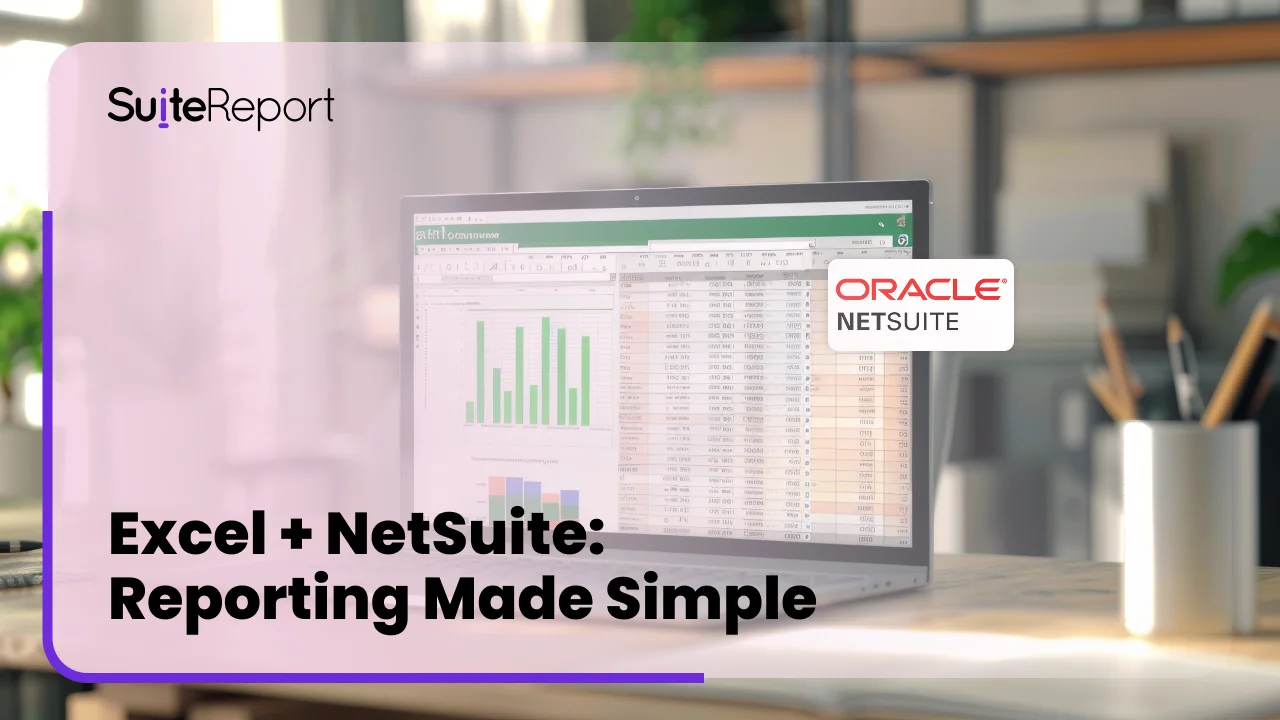For finance professionals, reporting is more than just a routine, it’s the backbone of strategic decision-making. If your business runs on NetSuite, you already know the value of the platform’s rich financial data. But when it comes to analysis, forecasting, and board-ready reports, Excel remains the go-to tool for many finance teams. That’s where NetSuite reporting in Excel becomes a powerful advantage.
This guide explores essential tips and tricks to help you make the most of Excel for your NetSuite data. Whether you’re building dashboards, automating reports, or running complex financial models, we’ll show you how to do it smarter, faster, and more accurately, with a little help from SuiteReport where needed.
The Frustration Finance Teams Know Too Well
- Exporting NetSuite data manually, over and over
- Version control issues across multiple Excel files
- Late nights fixing broken formulas and misaligned columns
- Wasted hours trying to make static data dynamic
Why Finance Teams Prefer Excel for NetSuite Reporting
As covered in our blog on why finance teams continue to rely on Excel for reporting, the flexibility it offers often outperforms built-in ERP reports like those in NetSuite. You can sort, filter, model, visualize, and format your financial data exactly how you want it.
That’s where NetSuite Excel integration makes a difference. Instead of relying on manual exports or outdated CSVs, integration lets you work with real-time, accurate data pulled directly from your NetSuite environment.
Bring Live NetSuite Data in Excel – Without the Hassle
One of the most important tips for finance teams is to ensure they’re working with live NetSuite data in Excel. Static exports can quickly become outdated, especially when you’re tracking metrics like cash flow, revenue, or expenses on a daily or weekly basis.
SuiteReport makes it simple to sync your saved searches and reports directly into Excel. With a few clicks, you can refresh data instantly, keeping your workbooks accurate and eliminating version control issues. This real-time connection means your dashboards and financial models always reflect the latest numbers, without the need to log in and out of NetSuite or rely on IT support.
Build on Existing Work with NetSuite Saved Searches in Excel
Most finance teams already rely on saved searches in NetSuite. So why not use those same assets in Excel?
By pulling NetSuite saved searches into Excel, you can reuse familiar datasets, but gain the flexibility to add formulas, custom metrics, and conditional formatting. This approach also improves collaboration, your finance team can own the reporting while your NetSuite setup remains clean and consistent.
SuiteReport enables you to import saved searches directly into Excel, and even schedule them to update automatically, ensuring consistency without the manual copy-paste routine.
Save Time by Automating NetSuite Reports in Excel
The biggest opportunity for finance professionals is efficiency. Automation of NetSuite reports in Excel allows you to create reusable templates for everything from monthly financials to weekly sales analysis.
With SuiteReport, automation becomes easy and scalable. You can schedule your reports to refresh at set intervals, distribute reports via email, or publish them to shared drives, all without manual input. This reduces the time spent on routine tasks and frees up capacity for deeper financial analysis and strategic work.
Set it once, and let the system do the heavy lifting.
Use the Right Tools: The Power of an Excel Add-in for NetSuite Reporting
If you’re still manually exporting data from NetSuite, it’s time to upgrade your process. Using an Excel add-in for NetSuite Reporting like SuiteReport provides a more streamlined workflow for retrieving, organizing, and updating data.
SuiteReport functions as an intuitive Excel extension designed specifically for finance teams. It eliminates the need to log into NetSuite repeatedly and provides a user-friendly way to pull specific records, fields, and saved searches into your spreadsheets, without coding or complex configuration.
Whether you're preparing monthly close packages, cash flow statements, or ad hoc reports, the Excel add-in simplifies your work and ensures consistency across the board.
Ask Excel, Get Answers, Powered by AI
SuiteReport also lets you interact with your NetSuite data in plain English, directly inside Excel.
- “Show Q2 revenue by region”
- “Which vendors had overdue invoices last month?”
- “List top 5 departments by expense”
And SuiteReport generates a fully structured report, chart, or summary. This natural-language capability saves time, reduces formula errors, and helps analysts focus on insights rather than formatting.
Explore more real-world use cases of AI in Financial Reporting
Go Beyond Numbers with NetSuite Financial Analysis in Excel
Having the data is just the first step. The real value comes from insight. Use Excel’s built-in features, pivot tables, charts, Power Query, and scenario modeling, to interpret your NetSuite data. You can build forecasts, analyze variances, track KPIs, or create visual dashboards that drive real understanding.
With SuiteReport feeding you the most accurate and up-to-date information, your analysis becomes faster, deeper, and more actionable. It’s the difference between spending hours chasing numbers and having the clarity to lead with confidence.
Practical Tips to Master NetSuite Reporting in Excel
Now that we’ve covered the core integrations and tools, let’s look at a few actionable tips to help you make the most of your Excel reports:
- Standardize Templates: Create report templates for recurring reports like P&Ls, balance sheets, and budgets. Then use SuiteReport to automate the data refresh.
- Segment Your Data: Use NetSuite’s class, department, or location fields in your saved searches. Once in Excel, filter or pivot by those segments to analyze performance.
- Audit and Validate: Use Excel formulas like IFERROR, VLOOKUP, or MATCH to cross-check numbers, spot inconsistencies, and ensure accuracy.
- Visualize for Impact: Turn your data into clear, concise visuals using Excel’s charting tools, helping stakeholders grasp insights quickly.
- Keep It Simple: Even with powerful tools like SuiteReport, avoid overcomplicating your workbooks. Focus on clarity, structure, and storytelling.
- Turn Your Questions into Reports: Use SuiteReport’s natural language search to build custom reports by typing simple prompts like “show revenue by item type this month.” This works for saved searches or ad hoc queries.
The SuiteReport Advantage
While NetSuite reporting in Excel unlocks powerful possibilities, managing the process manually can become overwhelming. That’s where SuiteReport comes in.
SuiteReport was built with finance professionals in mind. It simplifies everything from connecting to NetSuite, importing saved searches, automating refreshes, and distributing reports. And because it works directly within Excel, it requires minimal training or onboarding.
If your finance team is looking to save time, reduce reporting errors, and gain better insights into your data, SuiteReport is the smart next step.
Final Thoughts
In today’s fast-paced business environment, finance teams need tools that support both precision and agility. NetSuite reporting in Excel delivers exactly that: the structure of ERP with the flexibility of spreadsheets.
By integrating live NetSuite data in Excel, optimizing NetSuite saved searches, and automating reports with the help of tools like SuiteReport, you can eliminate manual bottlenecks and focus on what matters, making smarter, faster financial decisions.
Start mastering NetSuite reporting in Excel today, and let SuiteReport turn your spreadsheets into a real-time financial command center.
Want to see how SuiteReport works in Excel? Book your free demo

